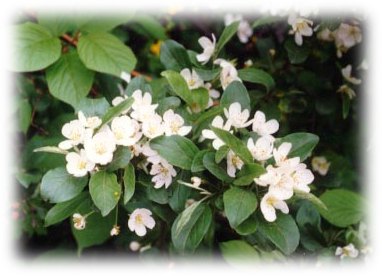Relatives
Malus mandshurica (Maxim.) Kom. - Manchurian crabapple.
Taxonomic position.
Family Rosaceae Juss., genus Malus Mill.Synonyms.
Pyrus baccata L. var. mandshurica Maxim., Malus baccata (L.) Borkh. subsp. mandshurica (Maxim.) Likhonos, M. baccata subsp. sachalinensis (Juz.) Likhonos, M. baccata var. mandshurica (Maxim.) Schneid., M. mandshurica subsp. sachalinensis (Juz.) Ponomarenko, M. sachalinensis Juz.Morphology and biology.
Tree, up to 12 m tall, with dark gray stems covered with rimose bark. Young offshoots vary from bare to pubescent and are reddish, reddish yellow or fulvous brown. Leaves are 3-7 cm long and 2-6 cm wide, varying from ovate and broadly elliptical to obovate, shortly acuminate, smooth-edged (either completely or at least in the lower part), less frequently serrate-dentate or finely crenate-dentate all round the edge, bare on the upper surface and bare to pubescent on the underside; young leaves are pubescent on both sides. Petioles are finely tomentose, 1-4 cm long. Flowers are grouped in 3-8 in umbellate inflorescences on the tips of shortened offshoots. Pedicels are 2.5-4.0 cm long. Sepals are lanceolate, pubescent from both sides, caducous under fruits. Corollas are white, pale pink in the budding phase, 3-4 cm in diameter, glandular. Fruits (pomes) are 8-15 mm in diameter, oblong-oval, less frequently orbicular, yellow with red sides, less frequently completely red. Entomophilous. Ornito- and zoochore. Propagated by seeds, root and softwood cuttings. Seeds should be stored for 1-3 months at 3-5╓C. Blossoms in May; bears fruit in early September. 2n = 34.Distribution.
Occurs throughout the Russian Far East (Maritime Region, Sakhalin, the Kuriles - Kunashir, Iturup), Korea, China (northeastern part), and Japan.Ecology.
Mesophyte. Shade-tolerant. Grows individually or in small groups in river valleys, in flood-plain coniferous-broadleaved forests, and on stony mountainsides at elevations of up to 900-1000 m above sea level. Best development is observed on sandy-pebbly alluvial soils with deep drainage; tolerates short-term floods.Utilization and economic value.
Food (fruit), ornamental, melliferous. Used as seedling stock, especially with small-fruit varieties (Chinese, rennet and crabapples).References:
Brezhnev D.D., Korovina O.N. 1981. Wild relatives of cultivated plants in the flora of the USSR. Leningrad: Kolos, pp. 238-239. (in Russian).Kharkevich S.S., ed. 1996. Vascular Plants of the Soviet Far East. Vol. 8. Leningrad: Nauka, pp. 153-154 (in Russian).
Koropachinskiy I.Yu., Vstovskaya T.N. 2002. Woody plants of the Asian part of Russia. Novosibirsk: Publishing House of SB RAS, Branch Geo, pp. 331-333 (in Russian).
Sokolov S.I., Svjaseva O.A., Kubli V.A. 1980. Areas of distribution of trees and shrubs in the USSR. Vol. 2. Leningrad: Nauka, pp. 59-60. (in Russian).


